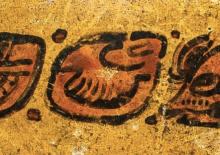Chi Pixab'
Solapas principales
El lingüista k'iche' Sam Colop (2008: 150n241) traduce el nombre Chi Pixab' como "lugar del consejo." Así es que el nombre resalta uno de los principios y valores mayas, según consta el sabio k'iche' José Yac Noj en su presentación Orientaciones Pedagógicas Salud y Nutrición Raxalaj K’aslemalil. Ukab’Ruk’u’xTijonik (Segundo Básico, ACEM. Maya Na’oj 2012): "Pixab'" significa "tomo consejo, tomar consejo."
Añaden Mondloch y Carmack (2018: 302) que la montaña Chi Pixab' está vinculado con la división precolombina del territorio maya: "Christenson (2003[2007]: 220) dice que yo (Carmack), identifiqué el Cerro Pixab' con una montaña ubicada entre los pueblos de San Andrés Sajk'ab'aja' y San Bartolomé Jocotenango. Sobre dicho cerro los ancestros k'iche's dividieron la Región Sur entre los diversos grupos invasores del Este, en la forma siguiente: los ahora llamados k'iche's al Noroeste y Suroeste; los tz'utujiles en los alrededores del Lago de Atitlán; los rabinales en las montañas y llanos al Este; y los vasallos kaqchikeles en la zona intermedia, entre tz'utujiles y k'iche's."
Anthropologist Allen J. Christenson (2007: 220n577) translates Chi Pixab' as "Place of Counsel or Instruction." He goes on to note, "Carmack identifies this as a mountain on the border between San Andrés Sajcabaja and San Bartolomé Jocotenango (Carmack 1981, 66). Here the nearby territory was divided between the major lineage groups—the Quichés, Tamub, and Ilocab settled the region to the north, centered on the mountain of Hacavitz [Jaqawitz]; the Ah Tsiquinahas (Tz'utuhils) settled the coastlands around Lake Atitlán; the Rabinals chose the mountains of the Rabinal basin to the east. The Cakchiquels at this time served as a lineage of vassal warriors and occupied a band of territory sitauted between the Quichés and and the Ah Tziquinahas, centered on the mountains above Chichicastenango. These mountain redoubts were apparently chosen for their defensive potential."
Notably, Chi Pixab' is the sacred space where community leaders engage in fasting, consuming only atole, made of maiz, depicted above in a codex-style bowl from the collection of the Fralin Museum of Art at the University of Virginia and interpreted by Looper and Polyukhovych (2016: 7). Ximénez (38v) links Chi Pixab and atole in slightly different ways in his K'iche'- and Spanish-language columns: "hu vc chiquicumeh ri xa hunai xim chiri cut ecaal vi chuvihuiub chipixab vbi/y solo vn trago de bebída bebían, y vn maís., y se estaban sobre el çerro de el mandato, ó auíso." In Spanish, the mountain is not named, but instead glossed by its meaning ("the mountain of command or advice"). Compare with the modern translations of Colop (1999[2004]: 140), "ju uk' chikiqumej, / ri xa juna ixim. / Chiri' k'ut eqal wi chuwi juyub', / Chi Pixab' ub'i'" and in Spanish (2008: 151): "sólo algo para beber hecho de una sola clase de maíz. / Allí, pues, cargados hasta la cima de la montaña llamada Chi Pixab..." For English, see Christenson (2007: 208): "They would drink only atole made of maize grains which they had borne to the top of the mountain named Chi Pixab."
Christenson (2007: 208fn589) explains atole ("vc" in colonial orthography and uk' in contemporary spelling) as such: "Uk' is any kind of drink other than water. In this case the text specifies that it is a drink made from maize, or in other words, an atole. Maize atole is the principal drink offered on ceremonial occasions in contemporary highland Maya society (Bunzel 1952, 45, 233-234; B. Tedlock 1982, 65-66). At Santiago Atitlán, this ceremonial atole is called maatz'. Unlike the usual type of maize drink which is made from watered-down corn dough, maatz' is made from grain that has been toasted and then ground fine before it is mixed with two handfuls of ash and placed in a boiling pot of water. This procedure, the only time that Atitecos grind maize kernels into dry flour, or allow maize to come into direct contact with fire, matches the Popol Vuh description of the underworld lords grinding the burned bones of Hunahpu and Xbalanque 'like finely ground corn flour' (Carlsen 1997, 57-59). Because traditionalist Atitecos believe that the preparation of maatz' is fraught with danger, it is carried out under the direction of the Xo', the wife of the head of the confraternity in which it is to be consumed. A confraternity elder blesses her beforehand so that she will not be burned in the process. I was told by a prominent Atiteco that drinking maatz' symbolizes victory over 'death and the fires of the underworld' (Christenson 2001, 123-124). The resulting mixture is sometimes addressed as mother’s milk or sperm, both associated with rebirth and regeneration (Freidel et al. 1993, 180). Although confraternity members frequently share food and drink in an atmosphere of informality sometimes bordering on the raucous, they drink maatz' with great solemnity. The highest ranking confraternity elder present distributes it to those present in order of their rank. As he does so he addressed each by name and title and calls on the patron saint of the confraternity to bless the recipient so that person’s feet, knees, heart, arms, head, and thoughts will have power and nothing untoward will happen to the individual during the year. The great Atiteco culture hero Francisco Sojuel is said to have called maatz' the true ruk'ux way (heart of food) and refused to eat anything else when carrying out important ceremonies (Mendelson 1957, 139)."
